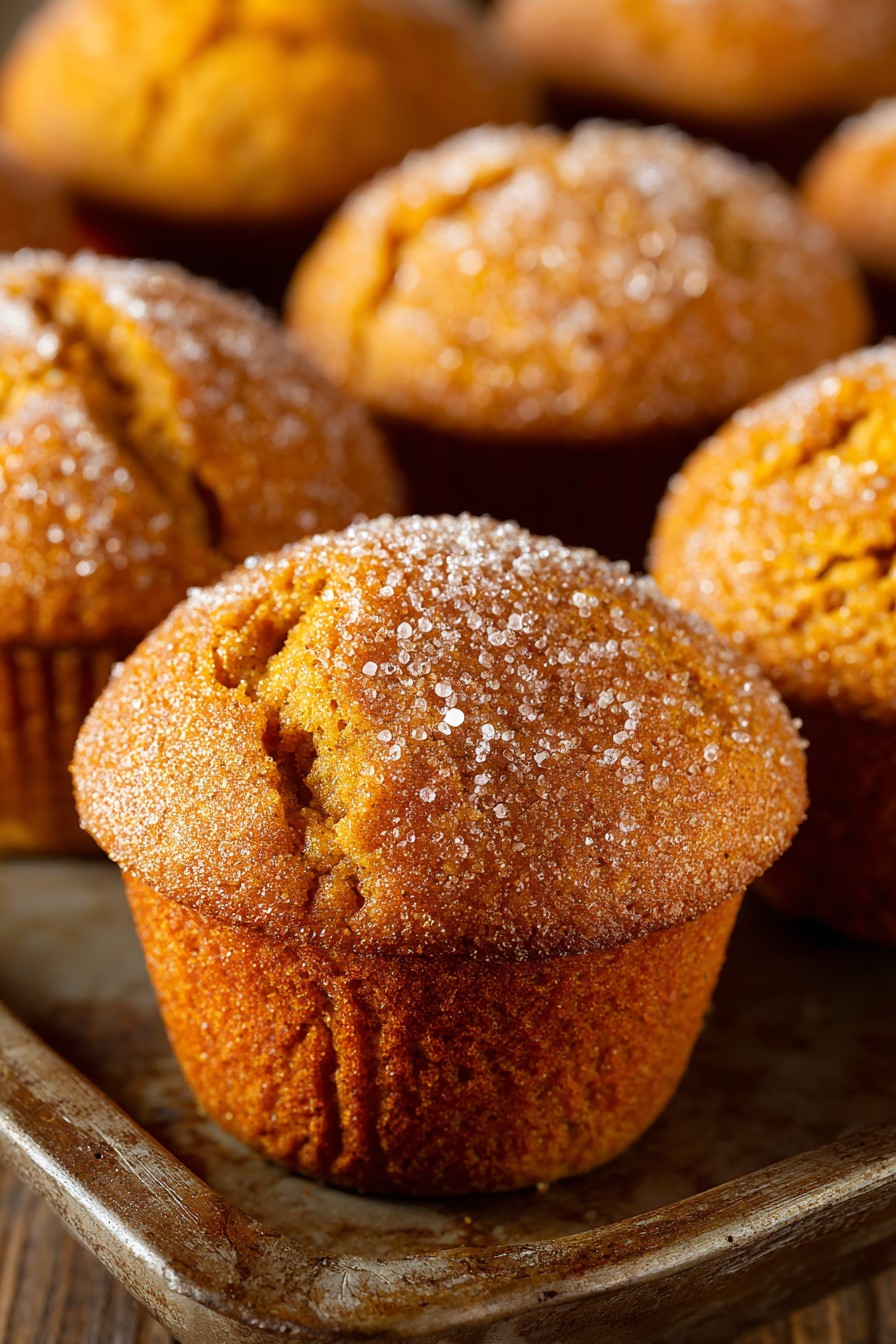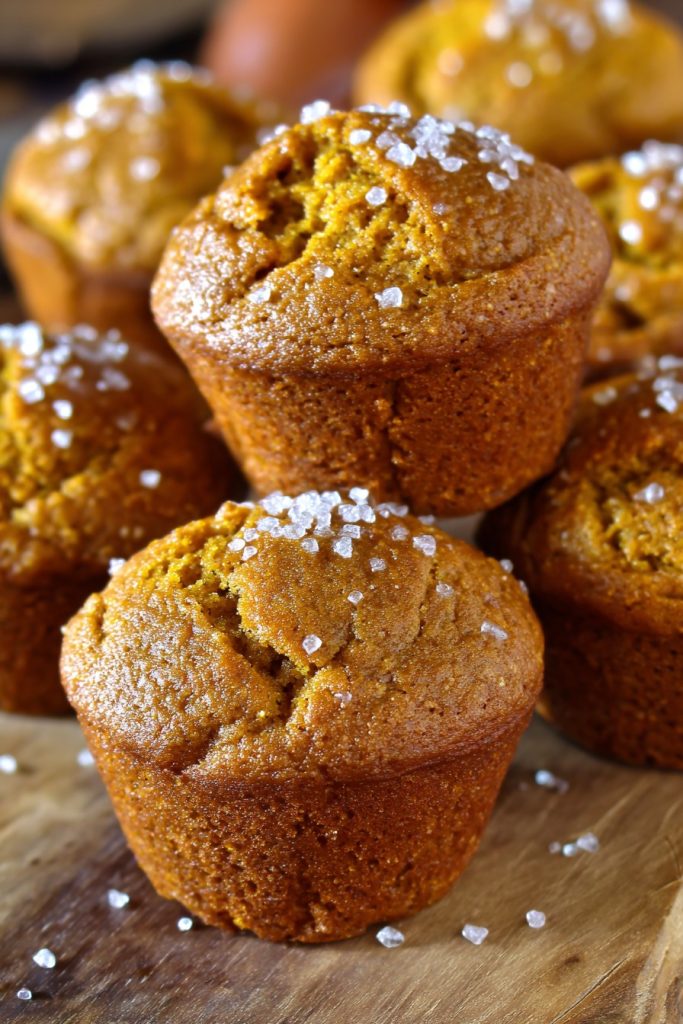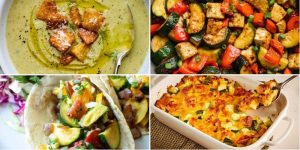Somewhere between the bustling spice markets of Istanbul and the cozy farmhouse kitchens of New England lies the perfect pumpkin muffin. Savoring these tender, spice-kissed creations transports you through centuries of culinary tradition, where pumpkin evolved from indigenous American sustenance to global comfort food phenomenon. The aroma alone—that magical blend of cinnamon, ginger, and nutmeg—whispers tales of ancient trade routes and colonial kitchen gardens coming together in perfect harmony.
Why This Recipe Works
- The combination of oil and buttermilk creates an exceptionally moist crumb that stays tender for days, reminiscent of the oil-based cakes found throughout Mediterranean baking traditions where olive oil has been prized for centuries
- Using both pumpkin puree and pumpkin pie spice delivers layered flavor complexity, much like the spice blends that traveled along the Silk Road from Southeast Asia to European kitchens
- The double-rising technique with baking powder and baking soda ensures a perfect dome rise, a technique perfected in American baking but with roots in chemical leavening discoveries across Europe
- Resting the batter allows the flavors to meld and hydrate fully, a practice common in French patisserie that transforms simple ingredients into something extraordinary
- The sugar sprinkle topping creates a delicate crystalline crust that contrasts beautifully with the soft interior, echoing the textural contrasts found in Middle Eastern pastries
Ingredients
- 2 cups all-purpose flour
- 1 ½ teaspoons baking powder
- ½ teaspoon baking soda
- 1 ½ teaspoons ground cinnamon
- ¾ teaspoon ground ginger
- ¼ teaspoon ground nutmeg
- ¼ teaspoon ground cloves
- ½ teaspoon salt
- 1 cup pumpkin puree
- ½ cup vegetable oil
- ¾ cup granulated sugar
- ¾ cup light brown sugar, packed
- 2 large eggs
- ½ cup buttermilk
- 1 teaspoon vanilla extract
- 2 tablespoons turbinado sugar for sprinkling
Equipment Needed
- Standard 12-cup muffin tin
- Paper liners or cooking spray
- Large mixing bowl
- Medium mixing bowl
- Whisk
- Spatula
- Ice cream scoop or ¼ cup measure
- Wire cooling rack
Instructions

Prepare Your Dry Ingredients and Spice Blend
Begin by whisking together your dry ingredients in that large mixing bowl, creating what French bakers would call the “fountain method” foundation. Measure 2 cups of all-purpose flour with the precision of a Parisian pastry chef, then add 1 ½ teaspoons baking powder and ½ teaspoon baking soda—these chemical leaveners work in beautiful synergy, much like the dual-rise techniques found in traditional German kuchen. Now for the spice symphony: 1 ½ teaspoons ground cinnamon that recalls the cinnamon stalls of Sri Lankan markets, ¾ teaspoon ginger with its fiery Asian origins, ¼ teaspoon freshly grated nutmeg that whispers of Caribbean plantations, and ¼ teaspoon cloves that transport you to the Moluccan spice islands. Finish with ½ teaspoon salt to balance the sweetness, just as salt has enhanced flavors from ancient Roman kitchens to modern fusion cuisine. Tip: For maximum flavor extraction, consider toasting whole spices and grinding them fresh, a technique used from Indian dhabas to Mexican molcajetes.
Combine Wet Ingredients and Pumpkin Puree
In your medium bowl, create the liquid gold that will transform your muffins. Start with 1 cup of pumpkin puree—imagine the bright orange flesh that sustained Native American communities for millennia before becoming the pumpkin pie filling we know today. Add ½ cup vegetable oil, which provides the tender crumb structure prized in oil-based cakes throughout Italy and Greece. Now incorporate ¾ cup granulated sugar and ¾ cup packed light brown sugar—this combination creates depth, with the molasses notes in brown sugar echoing the complex sugars found in Caribbean rum production. Crack in 2 large eggs, watching the golden yolks blend into the mixture like sunset over Tuscan hills. Finally, pour in ½ cup buttermilk for tangy tenderness and 1 teaspoon vanilla extract, that orchid-derived flavor that traveled from Mexico to global prominence. Whisk until the mixture resembles a smooth, spiced custard.
Combine Wet and Dry Mixtures
Now comes the alchemical moment where separate elements become one unified batter. Create a well in the center of your dry ingredients, a technique used by bakers from medieval Europe to modern patisseries. Pour the wet pumpkin mixture into this crater, then use your spatula to gently fold the ingredients together. Work with the light touch of a Japanese pastry chef crafting delicate wagashi—overmixing develops gluten and creates toughness, while undermixing leaves pockets of flour. The goal is what French bakers call “just incorporated,” where a few flour streaks remain but the batter is mostly homogeneous. The transformation is magical: the pale flour becomes a vibrant orange batter speckled with spices, reminiscent of the colorful spice piles in Moroccan souks. The aroma already tells the story of global culinary exchange.
Rest and Prepare Baking Environment
Here we employ a technique borrowed from both French patisserie and traditional bread baking: the rest. Cover your bowl with a kitchen towel and let the batter sit for 30 minutes at room temperature. During this time, magical things happen—the flour particles fully hydrate, the chemical leaveners begin their subtle work, and the spices bloom, releasing their essential oils much like they do in slow-simmered Indian curries. Meanwhile, preheat your oven to 425°F, that initial high heat crucial for creating the perfect dome rise. Line your muffin tin with paper liners or grease thoroughly with cooking spray, preparing the vessels that will cradle your creations. This waiting period builds anticipation, much like the rest periods in Italian pasta making or Chinese dough preparation.
Portion and Bake to Perfection
Using an ice cream scoop or ¼ cup measure, portion the batter evenly among the 12 muffin cups, filling each about ¾ full. This consistent portioning ensures even baking, a principle valued from professional French bakeries to home kitchens worldwide. Now for the finishing touch: sprinkle each muffin with turbinado sugar, those large crystals that will create a delicate, crackly crust reminiscent of Scandinavian pearl sugar toppings. Place the tin in your preheated 425°F oven and bake for 5 minutes, then without opening the door, reduce the temperature to 350°F and continue baking for 18-22 minutes. The initial high heat creates that beautiful dome while the lower temperature ensures thorough cooking without burning. Tip: For perfect doneness, look for golden-brown tops that spring back when gently pressed, just as bakers test cakes from Vienna to Tokyo.
Cool and Serve with Global Flair
Remove your beautifully domed muffins from the oven—they should be fragrant with the spices of international trade routes and golden like autumn leaves in New England. Let them cool in the pan for exactly 5 minutes, allowing the structure to set without becoming soggy from trapped steam, a technique perfected in American baking but with roots in global pastry wisdom. Then transfer to a wire rack to cool completely, the air circulation preventing moisture buildup just as proper cooling preserves French macarons and Italian biscotti. Serve warm with European-style butter, drizzle with Middle Eastern honey, or enjoy plain with coffee that traveled from Ethiopian highlands to your cup. Each bite tells a story of culinary convergence.
Tips and Tricks
For those seeking to elevate their pumpkin muffin game to professional levels, consider these advanced techniques drawn from global baking traditions. First, understand that pumpkin puree quality makes all the difference—seek out organic canned pumpkin or make your own by roasting sugar pumpkins until tender, then pureeing until smooth. This homemade approach connects you to generations of American cooks who preserved autumn harvests. When measuring flour, use the spoon-and-level method rather than scooping directly from the bag, a precision technique valued in French baking schools that prevents dense, dry results. For spice enthusiasts, consider creating your own custom blend by adding cardamom (beloved in Scandinavian and Indian baking) or allspice (a Jamaican staple) to the mix. Temperature control is crucial—ensure your ingredients are at room temperature before mixing, as cold ingredients can deflate the delicate air bubbles created by your leaveners. This principle applies across global baking, from Japanese soufflé pancakes to Austrian tortes. If you find your muffins browning too quickly, tent them with aluminum foil during the final baking minutes, a technique used in German stollen baking. For maximum moisture retention, store cooled muffins in an airtight container with a slice of bread—the bread absorbs excess moisture while keeping the muffins tender, a trick passed down through generations of home bakers. Finally, consider the freezing technique: wrap individual cooled muffins tightly in plastic wrap, then place in freezer bags for up to 3 months. This preservation method allows you to enjoy autumn flavors year-round, much like traditional food preservation techniques from Nordic countries to Asian communities.
Recipe Variations
- Transform your muffins into a German-inspired creation by adding ½ cup chopped toasted walnuts and ¼ cup golden raisins soaked in dark rum, creating a texture and flavor profile reminiscent of traditional German stollen. The nutty crunch contrasts beautifully with the soft crumb while the rum-soaked fruit adds sophisticated depth that elevates the humble muffin to holiday celebration status.
- For a Mexican twist, incorporate ½ cup Mexican chocolate chips and a teaspoon of ancho chili powder into the batter, creating a mole-inspired flavor profile that balances sweet, spicy, and bitter notes. The gentle heat from the chili powder enhances the warm spices while the chocolate melts into pockets of richness throughout each bite.
- Create a tropical Caribbean version by adding ½ cup shredded sweetened coconut and ¼ cup crushed pineapple (well-drained), then topping with a lime glaze made from powdered sugar and fresh lime juice. The coconut adds texture while the pineapple provides bright acidity that cuts through the richness, transporting your taste buds to island beaches.
- For an Italian-inspired variation, swirl in a ribbon of homemade ricotta mixture (ricotta, lemon zest, and powdered sugar) and finish with a sprinkle of pine nuts before baking. The creamy ricotta creates marbled pockets of richness while the pine nuts add Mediterranean crunch, creating a sophisticated breakfast pastry worthy of a Venetian café.
- Embrace Middle Eastern flavors by adding ¼ cup chopped dates and 2 tablespoons of tahini to the batter, then sprinkling with sesame seeds before baking. The dates provide natural caramel-like sweetness while the tahini adds nutty complexity, creating flavor layers that echo traditional Middle Eastern pastries like ma’amoul.
Frequently Asked Questions
Can I use fresh pumpkin instead of canned puree?
Absolutely, and doing so connects you to centuries of culinary tradition where cooks used fresh seasonal ingredients. Select a small sugar pumpkin (also called pie pumpkin) rather than larger carving varieties, as they have denser flesh and sweeter flavor. Cut the pumpkin in half, scoop out the seeds and strings, then roast cut-side down at 375°F for 45-60 minutes until completely tender. Once cooled, scoop the flesh from the skin and puree in a food processor or blender until perfectly smooth. The resulting puree will have brighter flavor and more vibrant color than canned, though you may need to drain excess liquid through cheesecloth to achieve the proper consistency. This method honors the ingredient’s journey from Mesoamerican staple to global kitchen star.
What’s the purpose of starting at high temperature then reducing?
This two-temperature technique creates the perfect muffin architecture that bakers have perfected through generations of experimentation. The initial blast of 425°F heat causes rapid expansion of the leavening gases and steam, creating that beautiful domed top that professional bakeries prize. After 5 minutes, the structure has set enough to maintain its shape, so reducing to 350°F allows the interior to bake through completely without over-browning the exterior. This method mimics the steam-injected ovens used in European artisan baking, where controlled temperature changes create ideal crumb structure. The result is muffins with height, tenderness, and even baking from center to edge.
Can I make these muffins ahead and freeze them?
Yes, and freezing actually enhances certain qualities while preserving that fresh-baked quality. Allow the muffins to cool completely after baking, then wrap individually in plastic wrap followed by aluminum foil or place in freezer-safe bags, removing as much air as possible. Properly wrapped, they’ll maintain optimal quality for 2-3 months in the freezer. When ready to enjoy, thaw at room temperature or warm gently in a 300°F oven for 10-12 minutes. The freezing process actually helps redistribute moisture throughout the crumb, much like the resting period in professional bread baking. This makes them an excellent option for holiday preparation or weekly meal planning.
Why use both oil and buttermilk instead of just butter?
This combination creates a superior texture that stays moist for days, drawing on techniques from various global baking traditions. Oil coats flour proteins more thoroughly than solid fat, preventing gluten development and resulting in an exceptionally tender crumb—a principle utilized in Mediterranean olive oil cakes. Buttermilk contributes tanginess that balances sweetness while its acidity reacts with baking soda to create additional lift. The combination ensures moisture retention that butter alone cannot provide, as butter contains water that evaporates during baking. This dual-liquid approach creates muffins that remain fresh longer, a quality valued in cultures where daily baking isn’t practical.
Can I substitute the spices with pumpkin pie spice blend?
Certainly, and this substitution reflects how spice blends have traveled and evolved across cultures. If using pre-mixed pumpkin pie spice, substitute 2 ½ teaspoons for the individual spices listed. However, creating your own blend allows for customization—perhaps increasing the ginger for more warmth like Jamaican ginger cakes or adding cardamom for Nordic flair. Commercial blends typically contain cinnamon, ginger, nutmeg, and allspice or cloves, mirroring the historical spice trades that connected continents. Either way, the spices should be fresh for maximum aromatic impact, as their volatile oils diminish over time, much like the precious spices that once traveled along ancient trade routes.
Summary
These pumpkin muffins embody global culinary heritage through perfect texture, balanced spices, and techniques drawn from baking traditions worldwide. Each bite tells a story of ingredients and methods that traveled across continents to create this ultimate autumn comfort food.
Best Pumpkin Muffins
5
servings15
minutes25
minutesIngredients
Instructions
- 1 Preheat oven to 425°F and line muffin tin with paper liners
- 2 Whisk dry ingredients in large bowl: flour, baking powder, baking soda, spices, salt
- 3 In separate bowl, whisk pumpkin puree, oil, sugars, eggs, buttermilk, and vanilla
- 4 Pour wet ingredients into dry ingredients and fold until just combined
- 5 Let batter rest 30 minutes, then portion into muffin cups
- 6 Sprinkle with turbinado sugar and bake at 425°F for 5 minutes
- 7 Reduce temperature to 350°F and bake 18-22 minutes until golden
- 8 Cool in pan 5 minutes, then transfer to wire rack



